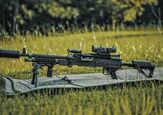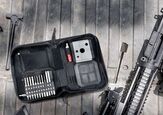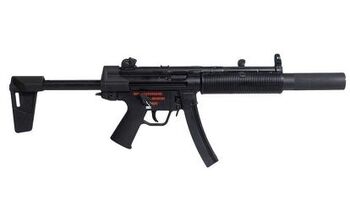An Old School Solution to a Very Modern Threat: Shotguns vs Drones

First Person View (FPV) drones have emerged in a few years as a very serious threat to military personnel and vehicles alike. Most armed forces have recognized the danger posed by this new weapon and are investing in solutions to counteract it, however, most developments are not man-portable. The humble shotgun can offer a last line of defense for the soldier and it seems to be making a resurgence on the battlefield. We’ll have a quick look at the present and potential future of drone-killing shotguns.
More Drone Warfare @ TFB:
The Threat - What Is an FPV Drone?
The threat here is relatively compact Unmanned Aerial Systems (UAS), many of commercial origin, that by having a forward-facing camera can be piloted remotely, far from the direct line of sight of the pilot.
These drones are usually piloted with a joystick controller, and their video signal is fed directly to the pilot's eyes via goggles.
These relatively simple and inexpensive electromechanical systems can be either of commercial origin or manufactured locally with commercially available and relatively inexpensive components, generally sourced from China.
Most systems are man-portable quad-copters and they range from “toy size” to “small table size”, and their use varies from reconnaissance to dropping explosive ordnance to delivering it with pinpoint accuracy with “kamikaze” missions.
The targets for the latter setup can be either vehicles (including tanks) or personnel. This is the type of drone that a soldier would be more likely trying to defend from.
Another feature of these FPV drones is the fact that all the footage that their cameras record is available to the operators and the successes are frequently uploaded online becoming both psychological warfare and a window on the battlefield.
Non-Destructive Countermeasures
If we focus on man-portable solutions, therefore excluding approaches such as vehicle-mounted lasers capable of burning UAS from afar, the options are limited to non-destructive electronic countermeasures.
We won’t go into detail about these solutions, but from this article, we can see an example:
Drone jammers were also in the spotlight and included everything from handheld, visual-range drone jammer guns to larger tripod-mounted jammers effective at ranges of up to a few kilometers. In the jamming department, some of the most impressive solutions were presented by the Australian company Drone Shield whose “DroneGuns” were used to take out four drones at the inauguration of Brazilian President Lula da Silva in January this year. The company’s new DroneGun Mk3 was on display at DSEI Japan and resembled an oversized pistol straight out of science fiction; it would fit in well with the Dominator from Psycho-Pass or the kit used by the Mobile Infantry from Starship Troopers. Yet despite appearances, the system weighs only 2.14 kg with battery – comparable to some models of the Desert Eagle. It typically takes about 1-2 seconds for the drone gun to force the drone into its loss of link protocol. Moreover, the system is fitted with a standard military battery that is interchangeable with other commonly used systems like the Harris PRC 152 which gives it additional points on the logistics side.
While there are drones that try to build resistance to these jammers by being able to switch radio frequencies, the Russo-Ukrainian war has shown that, on both sides, fiber optic-guided drones are becoming more and more prevalent. These drones carry a reel of about 20 km of optical fiber, without requiring any radio control for operation. This limits range, payload capacity, and may slow down the drone a bit, but the advantage is the immunity to jammers.
With the skies seeing more of these fiber-guided units, kinetic solutions going for a hard kill of the UAS are becoming more relevant.
Moreover, there are already reports of drones operating autonomously, requiring no direct human input to attack their target, again invalidating most electronic warfare solutions.
The Last Resort: The 12 Gauge Shotgun
Trying to shoot down with your firearm the drone that is hunting you is an instinctive reaction, and there are quite a few videos online showing failed attempts with assault rifles.
We’ve seen Russian forces attempting a few solutions to improve the odds, such as: trying to convert under-barrel grenade launchers into single-shot shotguns, installing muzzle devices capable of delivering shots, or crafting DIY salvo rounds for their 5.45x39mm rifles.
None of these solutions seems ideal given the small size of the target, the limited range of the rounds, and the likelihood of multiple shots necessary for a resolutive hit, however, they can still be an improvement whenever semiautomatic 12ga shotguns are not available.
Indeed there are video reports from the Russo-Ukrainian front showing soldiers equipped with radio jammers and hunting shotguns as their last line of defense.
The venerable 12ga seems to be gaining a new value on the battlefield.
Benelli, part of the Beretta Group, has already taken note and designed a version of the M4 deemed the A.I. Drone Guardian. AI here is not Artificial Intelligence, it stands for Advanced Impact, a particular internal profile of the barrel, meant to improve long-range performance.
12 Gauge Ammunition for Drone Hunting
The most obvious choice for dispatching small aerial threats is adopting rounds designed for bird hunting or clays, however, FPV drones (frequently adopting flexible plastic propellers) can be quite resilient, requiring dedicated solutions to improve effectiveness.
The Ukrainian Armed Forces report that the Russian Federation uses, among others, a round named PEREKHVAT, delivering a fragmented slug opening up into 6 projectiles connected by kevlar strings.
This round, reminiscent of some American exotic ammunition, such as this load and this one, and conceptually similar to ball-and-chain loads, is reportedly potentially effective up to 75 meters. While we can doubt its consistency of deployment, the Kevlar lines seem to be quite effective in tangling drone propellers.
In Europe, Norma Governmental, the defense division of the Swedish ammunition Manufacturer Norma AB, now part of the Beretta Group, has recently unveiled the AD-LER round (Anti-Drone Long Effective Range).
This 12ga ammunition packs 34 grams (1.2 oz) of #6 tungsten shot into 2 ¾ “ shells, and it’s meant to deliver drone-killing shots up to 100 meters from tactical shotguns with none to minimal choke.
Beretta Defense Technologies recently organized a live firing event in the UK where the Norma load was tested against drones.
Also, Fiocchi offers a dedicated drone defense load, with size #4 buckshot.
Counter FPV Training Approaches
While weapons and ammunition are vital components in the fight against FPV threats, their potential can go to waste without the right training. Marco Angelelli is one of the first publicly known trainers to offer a dedicated course for operators willing to gain more confidence in defending themselves from these flying weapons.
Mr Angelelli is a Lieutenant of the Italian Air Force and a former athlete of the Air Force Shooting Sports Group (Skeet) and the Italian National Military Team.
The fundamentals of Angelelli’s training lie in the clay shooting disciplines of Skeet and Compak Sporting declined to simulate realistic defense conditions, and they are briefly introduced in the booklet “Individual C-FPV drones with shotguns”.
While the booklet, available by contacting marcoangelelli@libero.it, can be a good guide to start training these skills autonomously, the 2-week course that Angelelli offers (in Italy), which includes shooting down drones, is guaranteed to deliver more effective results.
We can bet that it will be only a matter of time before we’ll see more of these initiatives across the world.
Options on the Market and 2025 Outlook
We can see that Beretta Defense Technology is active in providing solutions against these modern threats, by developing weapons (with aiming devices) and ammunition, and supporting training initiatives.
We can expect this trend to be replicated by other manufacturers; real tactical needs frequently find their way into the civilian market.
Which manufacturers would you, TFB readers, expect to be offering to the market dedicated drone-killing solutions?
Maybe Mossberg, a company quite active in offering shotguns for defense contracts?
Or maybe Genesis Arms will find a new niche for their awesome PDS? A longer barrel, coupled with FA operation may help in this task.
Will we see more dedicated ammunition? Or re-labeling of existing products to gain market share?

Italian firearm enthusiast, Giorgio has a passion for innovative or plainly unusual mechanical solutions. He's also interested in manufacturing technologies with a recent focus on additive manufacturing.You can contact him at giorgio_o at zoho dot com and you'll find him in the comments section as Giolli Joker.
More by Giorgio O
















![[IDEX 2025] Black Box For Small Arms - The FN SmartCore](https://cdn-fastly.thefirearmblog.com/media/2025/03/05/06581/idex-2025-black-box-for-small-arms-the-fn-smartcore.jpg?size=350x220)












![[SHOT 2025] Pulsar Launch the Thermion 2 LRF 60 Range of Thermals](https://cdn-fastly.thefirearmblog.com/media/2025/01/24/05431/shot-2025-pulsar-launch-the-thermion-2-lrf-60-range-of-thermals.jpg?size=350x220)
Comments
Join the conversation
I wonder how close an average small drone needs to get to a group of soldiers to cause damage with explosives? Shotguns with the right shells and patterns can get hits out to 150+ yards in the right hands, but 50 yard shots generally require a bit of skill to do consistently.
Perhaps a mention that here in the United States the FAA takes a very dim view of shooting down a drone. The penalties can be the same as shooting down an airplane. In other words, don’t try this at home.